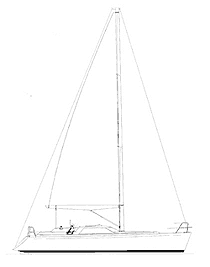North Wind 43
Bluewater cruiserr
The hull is certainly not svelte by any standard. The L/B is 3.04 and the D/L is 225. The overhangs are minimal with enough overhang forward to make handling the anchor less hazardous. I really like the shape of the fore-and-aft rocker of this hull. It's very clean looking, giving the boat a long and flat run aft. Note the huge rudder. No client ever calls me and says his rudder is too big. Draft is a sensible if conservative 6 feet, 4 inches and the rudder looks to come within 4 inches of that depth. I would think this yacht sails very well.
Much is made today of the Limit of Positive Stability, which generally for cruising boats is a number between 115 and 128 degrees. I see these numbers inflated in some ads to the point of incredibility. I also think the typical buyer puts far too much importance on this number. The calculations required to produce the LPS result in an overly simplistic and static look at a complex, highly dynamic and multidimensional problem. "Relax dear, we are only heeled 122 degrees and our LPS is 125 degrees." Not.
A recent study done in Australia after the calamitous 1998 Sydney Hobart race came up with some very interesting observations from a large panel of sailing and design experts including data derived from tank tests involving various simulated wave types and combinations. You can read a synopsis of this study in the February issue of the British magazine Seahorse.
After extensive testing the article says the experts came up with three major observations: first, and most obviously, that lowering the boat's VCG will result in an increase in the LPS; second that the bigger the boat the more resistant it is to capsize; and third, in the words of crewmembers caught in the Sydney Hobart storm, that in those conditions "It wouldn't have mattered what boat we were in, we were going to capsize." Exactly.
When assessing a boat's safety the focus should be not on when you go over but how quickly the boat can right itself. If everything about your boat looks relatively "normal" then you are going to have a "normal" stability profile.
The article goes on to say that the additional immersed volume provided by a cabintrunk in fact hindered a boat's ability to right itself when compared to a flush-deck model. This observation was based on tank tests using a model with a removable coach roof. Typically a designer or a builder may inflate his LPS by including the cabintrunk with the thought that the boat is now going to show increased stability.
The IMS-derived LPS for this design is an honest and acceptable 120.6 degrees with the standard keel. If you go to the optional 4 foot, 6 inches shoal keel your stability will be reduced.
This layout is very typical of the modern, center-cockpit boat, with the galley tucked into the passageway to the aft cabin. The nice thing about this galley location is that it has portlights looking out onto both the side deck and cockpit for excellent ventilation and light. Tanks are located under the raised saloon sole. There is excellent access to the engine through the aft head. This is a beautifully executed and comfy layout.
I like this design. I think this boat will sail well and transport its crew safely and in comfort with uncommon style.

Comments